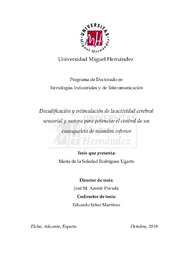Por favor, use este identificador para citar o enlazar este ítem:
https://hdl.handle.net/11000/5105Registro completo de metadatos
| Campo DC | Valor | Lengua/Idioma |
|---|---|---|
| dc.contributor.advisor | Azorín Poveda, José María | - |
| dc.contributor.author | Rodríguez Ugarte, María de la Soledad | - |
| dc.contributor.other | Departamentos de la UMH::Ingeniería de Sistemas y Automática | es |
| dc.date.accessioned | 2019-04-05T11:53:46Z | - |
| dc.date.available | 2019-04-05T11:53:46Z | - |
| dc.date.created | 2019-01-18 | - |
| dc.date.issued | 2019-04-05 | - |
| dc.identifier.ismn | 658 | - |
| dc.identifier.uri | http://hdl.handle.net/11000/5105 | - |
| dc.description.abstract | La presente tesis se centró en el estudio de interfaces cerebro-máquina (BMI: Brain-Machine Interfaces) basadas en se ñales electroencefalográficas (EEG) y en la estimulación transcraneal por corriente continua (tDCS: Transcranial Direct Current Stimulation) con el fin de controlar un exoesqueleto de miembro inferior en tiempo real. Uno de los objetivos principales fue desarrollar una BMI capaz de detectar en tiempo real la intención de movimiento o la distinción entre dos tareas cognitivas motoras. El segundo objetivo fue estudiar una configuración de tDCS capaz de mejorar el desempeño en las tareas cognitivas. Y el tercer objetivo fue controlar un exoesqueleto de miembro inferior utilizando la BMI y la configuraci ón de tDCS diseñadas. Inicialmente se evaluaron varios algoritmos y configuraciones de electrodos para que la BMI diseñada fuera capaz de detectar la intención del pedaleo mediante las señales EEG del usuario. Posteriormente se decidió cambiar de paradigma y diseño de la BMI para mejorar las detecciones cognitivas que hac´ıa la BMI. Para ello, se diseñaron BMIs que distinguían entre la imaginación de dos tareas cognitivas motoras: la relajación y ya sea el pedaleo o la marcha. Para los estudios de la tDCS, se probaron dos montajes diferentes para mejorar el desempeño de la detección de la imaginación de las tareas cognitivas. El primer montaje fue evaluado con el paradigma de identificar la relajación y la imaginación del pedaleo. Dicho montaje se focalizó en sobreexcitar el área de la corteza motora donde se encuentra la representación de las piernas en el cerebro. El segundo montaje se evaluó con el paradigma de detectar la relajación e imaginación de la marcha. Este montaje se centró en excitar tanto el cerebelo como la corteza motora donde se encuentra la representación de las piernas en el cerebro. Finalmente, se realizó una prueba piloto con usuarios sanos que controlaban un exoesqueleto de miembro inferior en tiempo real con la BMI diseñada a través de la detección de dos tareas cognitivas de imaginación. Para esta prueba los participantes fueron estimulados con el segundo montaje de tDCS. Con este estudio se comprobó que la BMI podía distinguir entre dos tareas de imaginación motora y que el montaje de tDCS mejoraba el desempeño de la detección. | es |
| dc.description.abstract | This thesis was focused on the study of brain machine interfaces (BMI) based on electroencephalographic signals (EEG) and transcraneal direct current stimulation (tDCS) with the aim of controlling a lower limb exoskeleton in real time. One of the main goals was to develop a BMI capable of detecting in real time the movement intent or the distinction between two cognitive motor tasks. The second goal was to study a tDCS configuration capable of improving the cognitive task performance. And the third goal was to control a lower limb exoeskeleton using the BMI and the tDCS configuration designed. Initially several algorithms and electrode configurations were evaluated so that the BMI designed was capable of detecting pedaling intent by means of the user’s EEG signals. Afterwards, the paradigm and design of the BMI were changed in order to improve the cognitive detections of the BMI. With this in mind, BMIs able to distinguish between the imagination of two cognitive motor tasks (relaxation and either pedaling or gait) were designed. For the tDCS studies, two different montages were tested to improve the detection of cognitive motor imagery tasks. The first montage was evaluated with the paradigm of identifying relaxation and pedaling motor imagery. This montage focused on overexciting the motor cortex area where the legs are represented in the brain. The second montage analyzed the paradigm of detecting relaxation and gait motor imagery. This montage concentrated on exciting both the cerebellum and the motor cortex area where the legs are represented in the brain. Finally, a pilot test with healthy subjects controlled a lower limb exoskeleton in real time with the BMI designed via the detection of two cognitive motor imagery tasks. In this experiment, participants were stimulated using the second tDCS montage. With this study, it was corroborated that the BMI could distinguish between two motor imagery tasks and that the tDCS montage improved the detection performance. | es |
| dc.format | application/pdf | es |
| dc.format.extent | 160 | es |
| dc.language.iso | spa | es |
| dc.rights | info:eu-repo/semantics/openAccess | es |
| dc.subject | Tratamiento de señales | es |
| dc.subject | Neurociencias | es |
| dc.subject | Tecnologías de las telecomunicaciones | es |
| dc.subject.other | CDU::6 - Ciencias aplicadas::62 - Ingeniería. Tecnología | es |
| dc.subject.other | CDU::6 - Ciencias aplicadas::68 -Tecnología cibernética y automática | es |
| dc.title | Decodificación y estimulación de la actividad cerebral sensorial y motora para potenciar el control de un exoesqueleto de miembro inferior | es |
| dc.type | info:eu-repo/semantics/doctoralThesis | es |

Ver/Abrir:
Tesis Rodriguez Ugarte, Maria de la Soledad_compressed.pdf
8,98 MB
Adobe PDF
Compartir:
 La licencia se describe como: Atribución-NonComercial-NoDerivada 4.0 Internacional.
La licencia se describe como: Atribución-NonComercial-NoDerivada 4.0 Internacional.
.png)